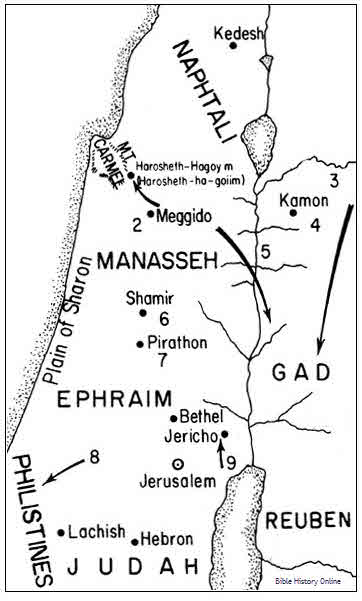The Judges in Ancient Israel

Map of Israel During
the Period of the Judges
Places that were associated with the Judges of ancient Israel.
(1) Home of Barak
(2) Deborah and Barak defeat Jabin and Sisera near the waters of Megiddo
(3) Jephthah banished to the land of Tob (top), where he is recalled,
defeats the Ammonites (bottom) and on his return sacrifices his
daughter.
(4) Kamon, the place where Jair was buried
(5) Gideon drives out the Midianites and other invaders from the eastern
desert.
(6) and (7) The region where Tola and Abdon lived
(8) From this area was the history of Samson and the Philistines
(9) Ehud drove the Moabites back and slew their king.
Judges 2:18 - And when the LORD raised them up judges, then the LORD was with the judge, and delivered them out of the hand of their enemies all the days of the judge: for it repented the LORD because of their groanings by reason of them that oppressed them and vexed them.
Judges 2:17 - And yet
they would not hearken unto their judges, but they
went a whoring after other gods, and bowed themselves unto them:
they turned quickly out of the way which their fathers walked in,
obeying the commandments of the LORD; [but] they did not so.
The Judges
Shamgar 3:31,
Tola 10:1-2,Jair 10:3-5,
Ibzan 12:8-10,Elon 12:11-12, and
Abdon 12:13-15.The other judges are viewed in greater detail in the Book of Judges:
Othniel 3:7-11 a nephew of Caleb, deliverered Israel from the Mesopotamians.Ehud 3:12-30 was lefthanded and killed Eglon, king of Moab.
Jephthah 11:1--12:7 was a harlot's son who defeated the Amorites.Gideon 6:11-8:35 led 300 Israelites to defeat the entire army of the Midianites.
Samson 13:1--16:31 delivered Israel from the Philistines. Known for his great strength.Deborah 4:1--5:31 urged Barak to attack the mighty army of the Canaanites.
The Judges in Smith's Bible Dictionary
Judges
The judges were temporary and special deliverers, sent by
God to deliver the Israelites from their oppressors; not supreme
magistrates, succeeding to the authority of Moses and Joshua. Their
power only extended over portions of the country, and some of them
were contemporaneous. Their first work was that of deliverers and
leaders in war; they then administered justice to the people, and
their authority supplied the want of a regular government. Even
while the administration of Samuel gave something like a settled
government to the south, there was scope for the irregular exploits
of Samson on the borders of the Philistines; and Samuel at last
established his authority as judge and prophet, but still as the
servant of Jehovah, only to see it so abused by his sons as to
exhaust the patience of the people, who at length demanded a king,
after the pattern of the surrounding nations. The following is a
list of judges, whose history is given under their respective
names:-- First servitude, to Mesopotamia -- 8 years. First judge:
Othniel. 40 years. Second servitude, to Moab -- 18 years. Second
judge: Ehud; 80 years. Third judge: Shamgar. --- Third servitude, to
Jabin and Sisera-- 20 years. Fourth judge: Deborah and Barak. 40
years. Fourth servitude, to Midian-- 7 years. Fifth judge: Gideon;
40 years. Sixth judge: Abimelech; 3 years. Seventh judge: Tola; 23
years. Eighth judge: Jair. 22 years. Fifth servitude, to Ammon-- 18
years. Ninth judge: Jephthah; 6 years. Tenth judge: Ibzan; 7 years.
Eleventh judge: Elon; 10 years. Twelfth judge: Abdon. 8 years. Sixth
servitude, to the Philistines-- 40 years. Thirteenth judge: Samson
20 years. Fourteenth judge: Eli; 40 years. Fifteenth judge: Samuel.
More than likely some of these ruled simultaneously. On the
chronology of the judges, see the following article.
Full Article
The Judges
in the Bible Encyclopedia - ISBE
3. The Six Invasions:
Six wars with other nations are recorded as taking place in this
period, and each called forth its judge or judges. Othniel delivered
the Israelites from the Mesopotamians or Edomites (Jdg 3:7-11), Ehud
from the Moabites (Jdg 3:12-30), Deborah and Barak from the
Canaanites (Judges 4; 5), Gideon from the Midianites (Judges 6
through 8), and Jephthah from the Ammonites (Jdg 10:6-12,17). In the
strife with the Philistines, which was not terminated during this
period, Samson (Judges 13 through 16), Eli (1 Sam 4 through 6), and
Samuel (1 Sam 7:3-14; 9:16) figure. Of these six wars those which
brought Othniel, Ehud and Jephthah to the front were less serious
and significant than the other three. The conflicts with the
Canaanites, Midianites and Philistines mark distinct stages in the
history of the period.
After the first successes of the Israelites in Canaan a period of
weakness and disintegration set in. The Canaanites, who still held
the fortified cities in the plain of Esdraelon, banded themselves
together and terrorized the region round about. The Hebrews fled
from their villages to the caves and dens. None had the heart to
offer resistance (Jdg 5:6,8). It seemed as though they were about to
be subdued by the people they had a short time before dispossessed.
Then it was that Deborah appeared on the scene. With her passionate
appeals in the name of Yahweh she awakened a new sense of national
unity, rallied the discouraged forces of the nation and administered
a final crushing defeat upon the Canaanites in the plain of Megiddo.
But the flame thus kindled after a time went out. New enemies came
from without. The Midianites invaded the land year after year,
robbing it of its produce (Jdg 6:1,3). This evil was suddenly put an
end to by the bold stroke of Gideon, whose victory was long
treasured in the public memory (Isa 9:4; 10:26; Ps 83:9-12). But the
people, at least of Manasseh and perhaps also of Ephraim, now
realized that it was no longer safe to depend upon such temporary
leadership. They needed a permanent organization to ward off the
dangers that beset them. They therefore offered the kingship to
Gideon. He formally declined it (Jdg 8:22,23), but still set up a
government at Ophrah which the people looked upon as hereditary (Jdg
9:2). He was succeeded by his son Abimelech, who, after slaying all
but one of his 70 brothers, assumed the title of king. The new
kingdom, however, was of short duration. It ended after three years
with the ignominious death of the king. Full Article
The Bible Mentions the "Judges" of Ancient Israel
Judges 2:18 - And when the LORD raised them up judges, then the LORD was with the judge, and delivered them out of the hand of their enemies all the days of the judge: for it repented the LORD because of their groanings by reason of them that oppressed them and vexed them.
Judges 2:17 - And yet
they would not hearken unto their judges, but they
went a whoring after other gods, and bowed themselves unto them:
they turned quickly out of the way which their fathers walked in,
obeying the commandments of the LORD; [but] they did not so.
Read The Bible
- 1599 Geneva Bible (GNV)
- 21st Century King James Version (KJ21)
- American Standard Version (ASV)
- Amplified Bible (AMP)
- Amplified Bible, Classic Edition (AMPC)
- Authorized (King James) Version (AKJV)
- BRG Bible (BRG)
- Christian Standard Bible (CSB)
- Common English Bible (CEB)
- Complete Jewish Bible (CJB)
- Contemporary English Version (CEV)
- Darby Translation (DARBY)
- Disciples’ Literal New Testament (DLNT)
- Douay-Rheims 1899 American Edition (DRA)
- Easy-to-Read Version (ERV)
- English Standard Version (ESV)
- English Standard Version Anglicised (ESVUK)
- Evangelical Heritage Version (EHV)
- Expanded Bible (EXB)
- GOD’S WORD Translation (GW)
- Good News Translation (GNT)
- Holman Christian Standard Bible (HCSB)
- International Children’s Bible (ICB)
- International Standard Version (ISV)
- J.B. Phillips New Testament (PHILLIPS)
- Jubilee Bible 2000 (JUB)
- King James Version (KJV)
- Lexham English Bible (LEB)
- Living Bible (TLB)
- Modern English Version (MEV)
- Mounce Reverse Interlinear New Testament (MOUNCE)
- Names of God Bible (NOG)
- New American Bible (Revised Edition) (NABRE)
- New American Standard Bible (NASB)
- New American Standard Bible 1995 (NASB1995)
- New Catholic Bible (NCB)
- New Century Version (NCV)
- New English Translation (NET)
- New International Reader's Version (NIRV)
- New International Version - UK (NIVUK)
- New International Version (NIV)
- New King James Version (NKJV)
- New Life Version (NLV)
- New Living Translation (NLT)
- New Matthew Bible (NMB)
- New Revised Standard Version (NRSV)
- New Revised Standard Version Catholic Edition (NRSVCE)
- New Revised Standard Version, Anglicised (NRSVA)
- New Revised Standard Version, Anglicised Catholic Edition (NRSVACE)
- New Testament for Everyone (NTE)
- Orthodox Jewish Bible (OJB)
- Revised Geneva Translation (RGT)
- Revised Standard Version (RSV)
- Revised Standard Version Catholic Edition (RSVCE)
- The Message (MSG)
- The Voice (VOICE)
- Tree of Life Version (TLV)
- World English Bible (WEB)
- Worldwide English (New Testament) (WE)
- Wycliffe Bible (WYC)
- Young's Literal Translation (YLT)
Table of Contents
Main Menu
- Ancient Assyrian Social Structure
- Ancient Babylonia
- Ancient Canaan During the Time of Joshua
- Ancient History Timeline
- Ancient Oil Lamps
- Antonia Fortress
- Archaeology of Ancient Assyria
- Assyria and Bible Prophecy
- Augustus Caesar
- Background Bible Study
- Bible
- Biblical Geography
- Fallen Empires - Archaeological Discoveries and the Bible
- First Century Jerusalem
- Glossary of Latin Words
- Herod Agrippa I
- Herod Antipas
- Herod the Great
- Herod's Temple
- High Priest's in New Testament Times
- Jewish Literature in New Testament Times
- Library collection
- Map of David's Kingdom
- Map of the Divided Kingdom - Israel and Judah
- Map of the Ministry of Jesus
- Matthew Henry Bible Commentary
- Messianic Prophecy
- Nero Caesar Emperor
- Online Bible Maps
- Paul's First Missionary Journey
- Paul's Second Missionary Journey
- Paul's Third Missionary Journey
- Pontius Pilate
- Questions About the Ancient World
- Tabernacle of Ancient Israel
- Tax Collectors in New Testament Times
- The Babylonian Captivity
- The Black Obelisk of Shalmaneser
- The Books of the New Testament
- The Court of the Gentiles
- The Court of the Women in the Temple
- The Destruction of Israel
- The Fall of Judah with Map
- The History Of Rome
- The Incredible Bible
- The Jewish Calendar in Ancient Hebrew History
- The Life of Jesus in Chronological Order
- The Life of Jesus in Harmony
- The Names of God
- The New Testament
- The Old Testament
- The Passion of the Christ
- The Pharisees
- The Sacred Year of Israel in New Testament Times
- The Samaritans
- The Scribes
Ancient Questions
- Why Do the Huldah Gates Appear Different in Ancient Replicas and Modern Photos?
- What Is the Origin of the Japanese and Chinese Peoples? A Biblical Perspective
- How did the ancient Greeks and Romans practice medicine and treat illnesses?
- What were the major contributions of ancient Babylon to mathematics and astronomy?
- How did the ancient Persians create and administer their vast empire?
- What were the cultural and artistic achievements of ancient India, particularly during the Gupta Empire?
- How did ancient civilizations like the Incas and Aztecs build their remarkable cities and structures?
- What were the major trade routes and trading practices of the ancient world?
- What was the role of slavery in ancient societies like Rome and Greece?
- How did the ancient Mayans develop their sophisticated calendar system?
Bible Study Questions
- Why Do Christians Celebrate Christmas?
- How Many Chapters Are There in the Bible?
- The Five Key Visions in the New Testament
- The 400-Year Prophecy: Unpacking Genesis 15 and the Journey of a People
- The Authorized (King James) Version (AKJV): Historical Significance, Translation Methodology, and Lasting Impact
- Exploring the English Standard Version (ESV): Its Aspects, Comparisons, Impact on Biblical Studies, and Church Use
- A Detailed Historical Analysis of Language Updates in the KJ21: Comparison with Other Versions
- A Detailed Historical Analysis of the American Standard Version (ASV): Comparison to the King James Version, Influence on Later Translations, and Evaluation of Strengths and Weaknesses
- A Detailed Historical Analysis of Amplifications in the Amplified Bible (AMP) and Its Comparison to Other Bible Translations
- Detailed Historical Analysis of the Amplified Bible Classic Edition (AMPC): Examples of Amplifications and Comparative Analysis with Other Bible Translations
About
Welcome to Free Bible: Unearthing the Past, Illuminating the Present! Step into a world where ancient history and biblical narratives intertwine, inviting you to explore the rich tapestry of human civilization.
Discover the captivating stories of forgotten empires, delve into the customs and cultures of our ancestors, and witness the remarkable findings unearthed by dedicated archaeologists.
Immerse yourself in a treasure trove of knowledge, where the past comes alive and illuminates our understanding of the present.
Join us on this extraordinary journey through time, where curiosity is rewarded and ancient mysteries await your exploration.
Recent posts
-

How Platzi AI Hiprex Trading Algorithms Are Outperforming Human Investors in 2025
The financial markets of 2025 are quicker, more complex, and extra records-pushed than ever earlier than. In this high-speed environment, even the max... -

Retail Traders Gain Edge with Quantum AI-Powered Market Insights
In these days’s hastily evolving monetary markets, technology is no longer only a device—it’s a competitive benefit. While institutional traders... -

Quantum AI Sets New Standard in Predictive Trading Accuracy
The monetary international isn't any stranger to change, but few innovations have disrupted conventional buying and selling pretty like synthetic inte... -

AI-Powered Trading Apps See Record Growth Among First-Time Investors
The panorama of investing is changing rapid. What was ruled through skilled investors and large institutions is now beginning up to a brand new genera... -

AI Trading Systems Surpass Human Performance in Real-Time Market Analysis
In the ever-evolving world of finance, pace and precision have become the cornerstones of successful buying and selling. As markets reply right away t...